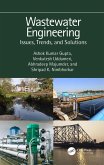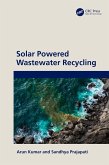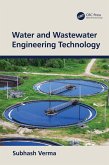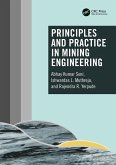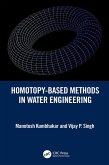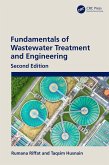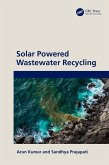Wastewater Engineering (eBook, PDF)
Issues, Trends, and Solutions


Alle Infos zum eBook verschenken

Wastewater Engineering (eBook, PDF)
Issues, Trends, and Solutions
- Format: PDF
- Merkliste
- Auf die Merkliste
- Bewerten Bewerten
- Teilen
- Produkt teilen
- Produkterinnerung
- Produkterinnerung

Hier können Sie sich einloggen

Bitte loggen Sie sich zunächst in Ihr Kundenkonto ein oder registrieren Sie sich bei bücher.de, um das eBook-Abo tolino select nutzen zu können.
Wastewater Engineering: Issues, Trends, and Solutions explains current treatment scenarios of wastewater in different countries across the globe, the characteristics of wastewater, and rules and regulations associated with the treatment and disposal/reuse of wastewater. It covers the design and theory involving laying of sewerage network and different conventional and advanced treatment technologies employed to treat domestic wastewater. It overviews different types of emerging contaminants and their properties, ecological impacts, detection/quantification, treatment technologies, and…mehr
- Geräte: PC
- mit Kopierschutz
- eBook Hilfe
![Wastewater Engineering (eBook, ePUB) Wastewater Engineering (eBook, ePUB)]() Ashok Kumar GuptaWastewater Engineering (eBook, ePUB)52,95 €
Ashok Kumar GuptaWastewater Engineering (eBook, ePUB)52,95 €![Solar Powered Wastewater Recycling (eBook, PDF) Solar Powered Wastewater Recycling (eBook, PDF)]() Arun KumarSolar Powered Wastewater Recycling (eBook, PDF)49,95 €
Arun KumarSolar Powered Wastewater Recycling (eBook, PDF)49,95 €![Water and Wastewater Engineering Technology (eBook, PDF) Water and Wastewater Engineering Technology (eBook, PDF)]() Subhash VermaWater and Wastewater Engineering Technology (eBook, PDF)98,95 €
Subhash VermaWater and Wastewater Engineering Technology (eBook, PDF)98,95 €![Principles and Practice in Mining Engineering (eBook, PDF) Principles and Practice in Mining Engineering (eBook, PDF)]() Abhay Kumar SoniPrinciples and Practice in Mining Engineering (eBook, PDF)47,95 €
Abhay Kumar SoniPrinciples and Practice in Mining Engineering (eBook, PDF)47,95 €![Homotopy-Based Methods in Water Engineering (eBook, PDF) Homotopy-Based Methods in Water Engineering (eBook, PDF)]() Manotosh KumbhakarHomotopy-Based Methods in Water Engineering (eBook, PDF)45,95 €
Manotosh KumbhakarHomotopy-Based Methods in Water Engineering (eBook, PDF)45,95 €![Fundamentals of Wastewater Treatment and Engineering (eBook, PDF) Fundamentals of Wastewater Treatment and Engineering (eBook, PDF)]() Rumana RiffatFundamentals of Wastewater Treatment and Engineering (eBook, PDF)46,95 €
Rumana RiffatFundamentals of Wastewater Treatment and Engineering (eBook, PDF)46,95 €![Solar Powered Wastewater Recycling (eBook, ePUB) Solar Powered Wastewater Recycling (eBook, ePUB)]() Arun KumarSolar Powered Wastewater Recycling (eBook, ePUB)49,95 €
Arun KumarSolar Powered Wastewater Recycling (eBook, ePUB)49,95 €-
-
-
Features:
- Gives an overview of current wastewater treatment scenarios across the world
- Provides insights into emerging contaminants sources, procedure to sample, available methods for analyses, and possible treatments
- Reviews existing rules and regulations on wastewater engineering and standards for wastewater disposal or reuse
- Includes how to use wastewater as a resource in the context of circular economy
- Describes fundamentals of wastewater conveyance and treatment
The book is aimed at graduate students and researchers in wastewater treatment, water, and environmental engineering.
Dieser Download kann aus rechtlichen Gründen nur mit Rechnungsadresse in A, B, BG, CY, CZ, D, DK, EW, E, FIN, F, GR, HR, H, IRL, I, LT, L, LR, M, NL, PL, P, R, S, SLO, SK ausgeliefert werden.
- Produktdetails
- Verlag: Taylor & Francis eBooks
- Seitenzahl: 348
- Erscheinungstermin: 24. Juli 2023
- Englisch
- ISBN-13: 9781000910827
- Artikelnr.: 68157131
- Verlag: Taylor & Francis eBooks
- Seitenzahl: 348
- Erscheinungstermin: 24. Juli 2023
- Englisch
- ISBN-13: 9781000910827
- Artikelnr.: 68157131
- Herstellerkennzeichnung Die Herstellerinformationen sind derzeit nicht verfügbar.
Venkatesh Uddameri earned his masters and doctoral degrees in civil engineering and environmental engineering, respectively, from the University of Maine, Orono, United States of America. Currently, he is Professor and Chair Professor in the Department of Civil and Environmental Engineering at Lamar University, Beaumont, Texas, United States of America. He has over 25 years of teaching, research, and professional experience in various aspects of water resources and environmental engineering. A significant part of his research is focused on alternative sources of water, including but not limited to the use of brackish groundwater resources and the reuse of wastewater. He is interested in the development of mathematical tools for the design and analysis of water and environmental systems. He is a fellow of the American Water Resources Association and currently serves as the Editor-in-Chief of the Journal of the American Water Resources Association. His research has been funded by a variety of federal, state, and local agencies, and he has received awards for both research and teaching innovations.
Abhradeep Majumder is a budding researcher in the field of water and wastewater treatment through biological and advanced oxidation processes. He earned his M.Tech in Civil Engineering with a specialization in Environmental Engineering from National Institute of Technology Agartala, Agartala, India. Currently, he is Senior Research Scholar from the School of Environmental Science and Engineering, Indian Institute of Technology Kharagpur, Kharagpur, India. His broad field of research is wastewater treatment. His research work is dedicated to the development of photocatalytic materials for degrading emerging organic contaminants present in wastewater and using mathematical modelling to describe their degradation process. He also has experience in the biological treatment of wastewater. His scientific contribution is marked by several publications on advanced oxidation processes, emerging contaminants, biological treatment, adsorption, and others in top-ranking international journals. He has 20 publications in top-ranking international journals and is credited with more than 800 citations with a h-index of 13.
Shripad K. Nimbhorkar earned his M.Tech in Environmental Science and Engineering from the Indian Institute of Technology Bombay, Mumbai, India. He has more than 40 years of experience in the field of industrial water and wastewater treatment. He has worked with renowned industrial wastewater treatment solution companies. He has been the Associate Vice President at Kirloskar Consultants, Bangalore, India, and Reva Enviro Systems Private Ltd., Nagpur, India, between 1988 and 1995. He was also the General Manager of Biosystems India Ltd., Ahmedabad, India. Furthermore, Mr. Nimbhorkar had also held the position of Lecturer at Maulana Azad College, Aurangabad, India, and been an Environmental Management System Auditor. His field of interest is wastewater management, wastewater reuse, and the use of renewable energy in wastewater treatment.
Wastewater Management 1.3. Challenges in Wastewater Management 1.4.
Current Wastewater Management Scenario 1.5. Approaches to Sustainable
Wastewater Management 1.6. Overview of Processes Involved in a Typical
Sewage Treatment Plant 1.7. Chapter Summary 1.8. Concluding Remarks 2.
Wastewater: Sources, Characterization, and Analysis 2.1. Introduction
2.2. Components of Sewage 2.3. Characteristics of Sewage 2.4. Important
Parameters of Wastewater and Their Analysis 2.5. Chapter Summary 2.6.
Concluding Remarks 3. Legal Aspects of Municipal Wastewater Management and
Standards 3.1. Introduction 3.2. Existing Legislative Mandates for
Wastewater Management across the World 3.3. Wastewater Discharge
Standards 3.4. Wastewater Reuse Standards 3.5. Sludge Disposal
Regulations 3.6. Chapter Summary 3.7. Concluding Remarks 4. Wastewater
Treatment System 4.1. Introduction 4.2. Types of Treatment Systems 4.3.
Sewerage System 4.4. Chapter Summary 4.5. Concluding Remarks 5. Overview
of Conventional Wastewater Treatment Processes: Primary Treatment 5.1.
Introduction 5.2. Screening 5.3. Grit Removal 5.4. Sedimentation 5.5.
Chapter Summary 5.6. Concluding Remarks 6. Overview of Conventional
Wastewater Treatment Processes: Secondary Treatment 6.1. Introduction
6.2. Aerobic Treatment Process 6.3. Anaerobic Wastewater Treatment 6.4.
Secondary Settling 6.5. Post-Aeration 6.6. Chapter Summary 6.7.
Concluding Remarks 7. Overview of Conventional Wastewater Treatment
Processes: Tertiary Treatment 7.1. Introduction 7.2. Chemical
Precipitation 7.3. Filtration 7.4. Adsorption 7.5. Disinfection 7.6.
Chapter Summary 7.7. Concluding Remarks 8. Sludge Management in
Wastewater Treatment Plants 8.1. Introduction 8.2. Classification of
Sludge and Their Properties 8.3. Quantification of Sludge Production 8.4.
Conventional Procedures for the Management of Wastewater Treatment Plant
Residues 8.5. Innovative Technologies for Sludge Management 8.6. Sludge
Disposal 8.7. Chapter Summary 8.8. Concluding Remarks 9. Emerging
Contaminants in the Aqueous Environment: Detection and Quantification,
Ecological Impacts, and Legislations 9.1. Introduction 9.2. Sources and
Pathways of Emerging Contaminants into Various Aqueous Environments 9.3.
Analysis of Emerging Contaminants 9.4. Ecological Impacts of Emerging
Contaminants 9.5. Guidelines and Standards Pertaining to Emerging
Contaminants 9.6. Chapter Summary 9.7. Concluding Remarks 10. Emerging
Contaminants in the Aqueous Environment: Treatment Technologies for
Emerging Contaminants and Its Application 10.1. Introduction 10.2.
Biological Processes 10.3. Advanced Oxidation Process 10.4. Adsorption
and Membrane-Based Technologies 10.5. Hybrid Processes 10.6. Case Studies
on the Treatment of Emerging Contaminants 10.7. Chapter Summary 10.8.
Concluding Remarks 11. Sustainable Treatment Technologies for Achieving
Circular Economy 11.1. Introduction 11.2. Life Cycle Assessment 11.3.
Resource Recovery 11.4. Chapter Summary 11.5. Concluding Remarks
Wastewater Management 1.3. Challenges in Wastewater Management 1.4.
Current Wastewater Management Scenario 1.5. Approaches to Sustainable
Wastewater Management 1.6. Overview of Processes Involved in a Typical
Sewage Treatment Plant 1.7. Chapter Summary 1.8. Concluding Remarks 2.
Wastewater: Sources, Characterization, and Analysis 2.1. Introduction
2.2. Components of Sewage 2.3. Characteristics of Sewage 2.4. Important
Parameters of Wastewater and Their Analysis 2.5. Chapter Summary 2.6.
Concluding Remarks 3. Legal Aspects of Municipal Wastewater Management and
Standards 3.1. Introduction 3.2. Existing Legislative Mandates for
Wastewater Management across the World 3.3. Wastewater Discharge
Standards 3.4. Wastewater Reuse Standards 3.5. Sludge Disposal
Regulations 3.6. Chapter Summary 3.7. Concluding Remarks 4. Wastewater
Treatment System 4.1. Introduction 4.2. Types of Treatment Systems 4.3.
Sewerage System 4.4. Chapter Summary 4.5. Concluding Remarks 5. Overview
of Conventional Wastewater Treatment Processes: Primary Treatment 5.1.
Introduction 5.2. Screening 5.3. Grit Removal 5.4. Sedimentation 5.5.
Chapter Summary 5.6. Concluding Remarks 6. Overview of Conventional
Wastewater Treatment Processes: Secondary Treatment 6.1. Introduction
6.2. Aerobic Treatment Process 6.3. Anaerobic Wastewater Treatment 6.4.
Secondary Settling 6.5. Post-Aeration 6.6. Chapter Summary 6.7.
Concluding Remarks 7. Overview of Conventional Wastewater Treatment
Processes: Tertiary Treatment 7.1. Introduction 7.2. Chemical
Precipitation 7.3. Filtration 7.4. Adsorption 7.5. Disinfection 7.6.
Chapter Summary 7.7. Concluding Remarks 8. Sludge Management in
Wastewater Treatment Plants 8.1. Introduction 8.2. Classification of
Sludge and Their Properties 8.3. Quantification of Sludge Production 8.4.
Conventional Procedures for the Management of Wastewater Treatment Plant
Residues 8.5. Innovative Technologies for Sludge Management 8.6. Sludge
Disposal 8.7. Chapter Summary 8.8. Concluding Remarks 9. Emerging
Contaminants in the Aqueous Environment: Detection and Quantification,
Ecological Impacts, and Legislations 9.1. Introduction 9.2. Sources and
Pathways of Emerging Contaminants into Various Aqueous Environments 9.3.
Analysis of Emerging Contaminants 9.4. Ecological Impacts of Emerging
Contaminants 9.5. Guidelines and Standards Pertaining to Emerging
Contaminants 9.6. Chapter Summary 9.7. Concluding Remarks 10. Emerging
Contaminants in the Aqueous Environment: Treatment Technologies for
Emerging Contaminants and Its Application 10.1. Introduction 10.2.
Biological Processes 10.3. Advanced Oxidation Process 10.4. Adsorption
and Membrane-Based Technologies 10.5. Hybrid Processes 10.6. Case Studies
on the Treatment of Emerging Contaminants 10.7. Chapter Summary 10.8.
Concluding Remarks 11. Sustainable Treatment Technologies for Achieving
Circular Economy 11.1. Introduction 11.2. Life Cycle Assessment 11.3.
Resource Recovery 11.4. Chapter Summary 11.5. Concluding Remarks

